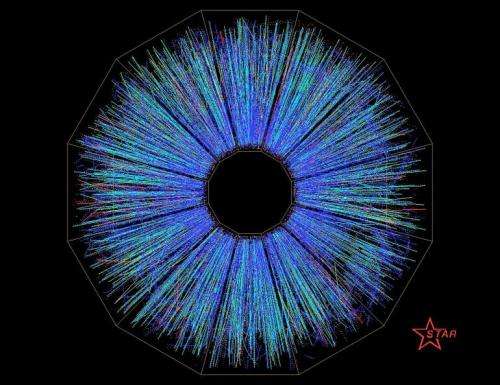February 12, 2014 report
What are the chances that a particle collider's strangelets will destroy the Earth?

(Phys.org) —At the Relativistic Heavy Ion Collider (RHIC) at Brookhaven National Laboratory (BNL) in Long Island, New York, scientists study high-speed ion collisions that reveal what the universe may have looked like moments after the Big Bang. RHIC is the second-highest-energy heavy-ion collider in the world, after the Large Hadron Collider (LHC), and currently the only operating particle collider in the US.
Even before RHIC began operating in 2000, some people worried that the unprecedented experiment would pose risks of potentially catastrophic scenarios. Some of the concerns included the creation of a black hole or production of strange matter that could result in the destruction of the Earth, possibly within seconds.
In 1999, before the collider opened, the media attention on the subject prompted BNL to form a committee of scientists to investigate the probability of such catastrophic scenarios. A few months later, the committee concluded that RHIC was safe.
RHIC has now been running for nearly 15 years, and scientists have used it to make many fascinating discoveries, such as that of a quark-gluon plasma with a temperature of 4 trillion K. This liquid-like substance is unlike any kind of normal matter and recreates the conditions that existed during the first seconds of the universe.
But due to budget cuts, in 2013 a government advisory panel recommended shutting down RHIC in the coming years as funding is put toward other projects. The US Consolidated Appropriations Act of 2014, passed just a few weeks ago, includes a provision for the establishment of a nine-member commission to evaluate the cost-effectiveness of all of the US national labs, including RHIC. It's called the Commission to Review the Effectiveness of the National Energy Laboratories.
According to Eric E. Johnson, Associate Professor of Law at the University of North Dakota, and Michael Baram, Professor Emeritus at Boston University Law School, this may also be a good time to reevaluate the safety risks at RHIC. They have written an opinion piece on the subject that is posted at International Business Times.
Johnson and Baram are calling for the new commission to look into the risks of RHIC destroying the Earth in addition to evaluating the financial aspects. A large part of the motivation for their appeal is because of the ongoing upgrades to RHIC. The collider is preparing for its 14th run, where it will be operating at 18 times the luminosity for which it was originally designed. The high luminosity will enable scientists to conduct more detailed studies of the quark-gluon plasma's properties and investigate how it transitions into the normal matter that we see in the universe today.
Another area that Johnson and Baram argue begs some scrutiny is that RHIC is now running at lower energies than in the past. Somewhat counterintuitively, lower energies may pose a higher risk than higher energies. In the original risk assessment report in 1999, the scientists stated that "Elementary theoretical considerations suggest that the most dangerous type of collision is that at considerably lower energy than RHIC." That assessment referenced RHIC's original design energy of 100 GeV. Over the years, lower-energy experiments were performed, and the 2014 run will include three weeks at 7.3 GeV.
Johnson and Baram are concerned that these changes might increase the possibility that the collider will generate strangelets, hypothetical particles consisting of up, down, and strange quarks. Some hypotheses suggest that strangelet production could ignite a chain reaction converting everything into strange matter.
In their opinion piece, Johnson and Baram quote Sir Martin Rees, Astronomer Royal of the United Kingdom, who stated that the Earth would then become "an inert hyperdense sphere about one hundred metres across."
Along with other critics concerned with safety, Johnson and Baram are concerned that the original risk assessment in 1999 was biased because all of the committee members were either planning to participate in RHIC experiments or had a deep interest in the RHIC's data. The diversity of the new commission may allow it to overcome that problem.
Since the new commission will reflect a broad range of expertise in science, engineering, management, and finance, Johnson and Baram think that "this gathering of talent is a unique opportunity to ensure the RHIC gets the rigorous, independent risk analysis it has long warranted."
"The luminosity upgrade, along with other evolutions of the RHIC program—including running collisions at different energies—suggests that the question of risk needs a fresh look," Johnson told Phys.org. "For example, one of the reassurances given in the original safety report in 1999 was that the RHIC would run at a relatively high energy that would make strangelet formation less likely. But now the RHIC is being run at much lower energies. So, a re-evaluation is in order.
"Bottom line, I can't say whether or not the RHIC program is so risky that it should be shut down. But I do think it's clear that the original safety assessment lacked independence and that it is now woefully outdated. The Commission to Review the Effectiveness of the National Energy Laboratories is an opportunity to look at the issue in a fair and complete way."
In the end, the dilemma raises the question of whether and how to perform unbiased low-probability, high-impact risk assessment for large science experiments—and whether it's possible to achieve this feat in a way that satisfies everyone.
© 2014 Phys.org





















